“In a few years, people will do tours here,” a review on Google Maps says, giving a rating of five stars to an inconspicuous rear courtyard in the midst of huge tower blocks in an average Minsk residential area. The story of the courtyard on Orshanskaya Street in the north of Minsk shows once again that huge marches and strikes are not the only type of protest happening in Belarus – and that creativity often plays a role in protests too.
The story of Change Square begins on 18 August 2020, when an unknown artist painted portraits of Ulad Sakalouski and Kiryl Halanau on a transformer station. These two DJs had previously played Peremen (“Change”) [a protest song by Viktor Zoi – editor’s note dekoder] during a pro-government event – a move that got each of them ten days under house arrest.
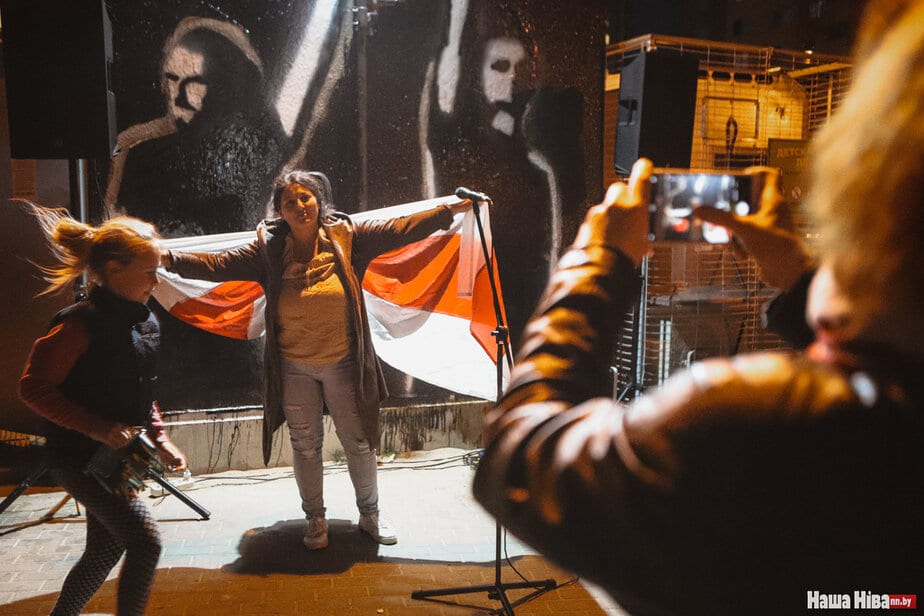
Photo: © Nadzeya Buzhan / Nasha Niva
Graffiti usually doesn’t last very long, especially when it has a clear political message. It looked like this graffiti would face a similar fate when a group of government workers painted over it the very next day. But, as it turns out, that was just the beginning…
Surrounded by high rises, this average courtyard in Minsk has achieved cult status in just a few weeks. Residents spray-painted the likeness of DJ Sakalouski and DJ Halanou on a wall, hung a giant white, red and white flag between the buildings, decorated the fence with hundreds of colourful ribbons, and posted a sign on the transformer building that said Change Square.
SilovikiSimilar to Russia, the collective term siloviki also denotes officials from the state’s security organs in Belarus. and municipal personnel come to Change Square every day to remove the flags and ribbons and paint over the mural. But residents don’t let up. They wash the paint off the DJs’ portraits, tie new ribbons, and hang new flags. In the evening, people gather on the square to network, dance, sing, and meet friends. Musicians and actors from Kupalauski TheatreThe Janka Kupala Theater is a traditional theater in the center of Minsk. It was named after the Belarusian poet and writer Janka Kupala (1882–1942). During the protests in Belarus in August 2020 against the election fraud and police violence, the director and former minister of culture Pavel Latushko was dismissed for critical remarks. Numerous actors and employees followed Latushko and also left the theater. have performed here, the square got its own Instagram account and you can even find Change Square on Google Maps and Yandex Taxi.Yandex is a Russian-Dutch stock corporation and is the market leader in Internet search in Russia, ahead of Google. In addition to this core business, Yandex offers other services such as webmail or music streaming. The state-owned Sberbank has owned shares in the company since 2009. Shareholders who want to acquire 25% or more shares in Yandex have since then required the bank’s supervisory board’s approval. According to a law currently discussed in the State Duma, news aggregators such as Yandex or Google may not be foreign-owned with more than 20% shares. If this law comes into force, Yandex is threatened with extinction in Russia. .
On the evening of 9 September, it is as lively as usual on Change Square. A dozen people have assembled in the courtyard. During the day, city personnel tried to paint over the mural of the DJs but residents reclaimed it almost immediately. The DJs’ faces now shine proudly on the wall with the white, red and white flag and the flag of Minsk above them. Below them, children and dogs run around. The adults are waiting for a concert. Today, Smizer VaizyushkevichŹmicier Vajciuškievič (* 1971) is a famous Belarusian singer and songwriter. is set to take the stage in this popular space.
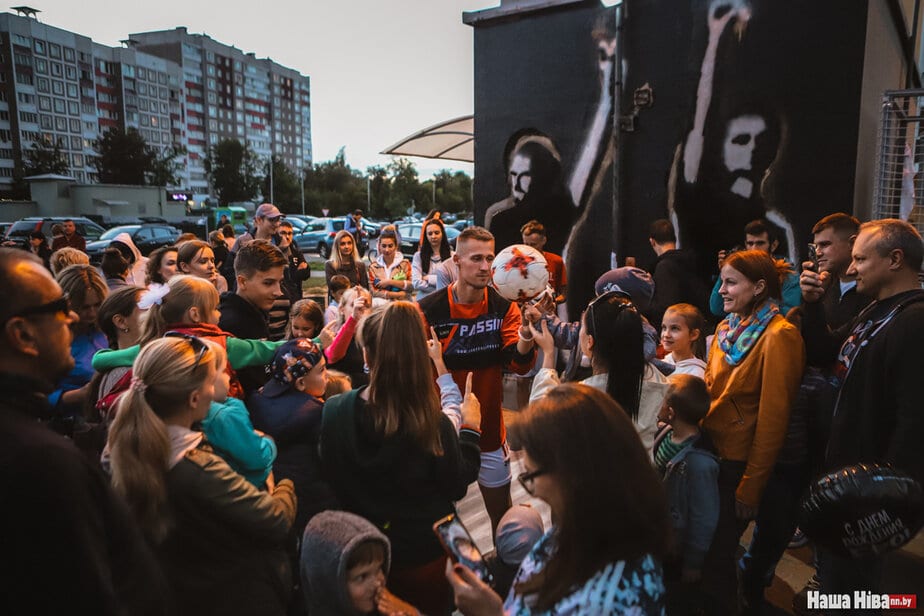
Photo: © Nadzeya Buzhan / Nasha Niva
“This happens almost every day. It started around 12 August. People started meeting in the courtyard and got to know each other. Later on, the mural appeared, and people set up their own chat group, not just for those who live here but for the whole neighbourhood,” a resident says. “With time they had all gotten to know each other. People started going to the protests together, supporting each other like true neighbours. Some residents complained about the noise. We respected that, and now we only meet here until 10 pm. There was one babushka who cut up the ribbons. We talked with her and exchanged opinions. She has her opinion and we have ours, and that’s okay. She promised us not to sabotage us again. That was it. We haven’t had any other problems.”
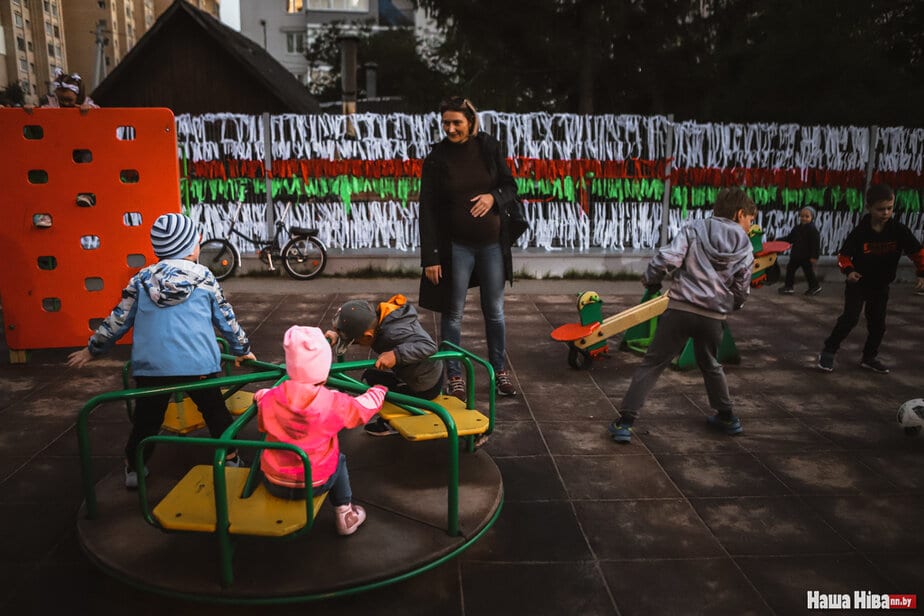
Photo: © Nadzeya Buzhan / Nasha Niva
The ribbons are tied to the fence around the playground. A giant white, red and white flag used to hang between the buildings, but the siloviki have since removed it – they had to cut open the door to the roof to get to it. Instead of the flag there is now the fence, which is completely covered with ribbons, some of them white, red and white, others red and green.The red and green flag became the official flag of the Republic of Belarus in 1995. It is based on the flag of the Belarusian Soviet Socialist Republic. It has replaced the white, red, and white flag that was the national flag after the Soviet Union’s collapse. After the massive falsifications in the 2020 presidential election, it symbolizes large parts of the opposition. In contrast, the red and green flag is a symbol for supporters of the Lukashenko regime. They try to remove those on a regular basis too.
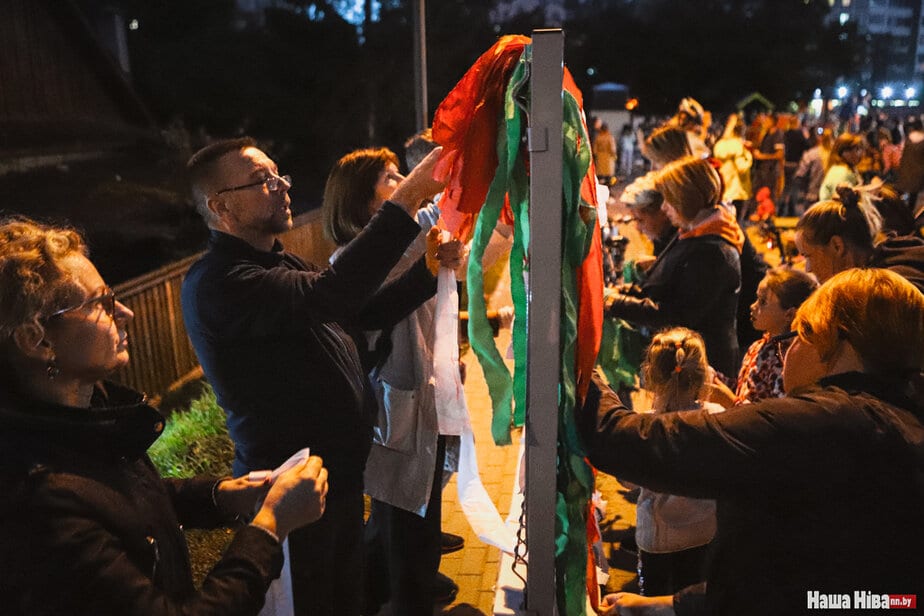
Photo: © Nadzeya Buzhan / Nasha Niva
“Today they sent three workers, with four masked men behind them. They removed some of the ribbons, and then they just left. Maybe it helped that some residents came and appealed to their conscience. That probably made them uncomfortable,” the people tell me. Now residents are tying the ribbons back on again. Their children are helping them. They say that this is all happening without any kind of organisation. No one is collecting money for the ribbon material – people bring their own, whatever they think they need. The job of reclaiming the murals falls to whoever is there at the time and feels like doing it.
“The women sewed the big flag. But we decided not to hang it yet, because they’ve started to threaten our tenants’ associations with penalties. 18,000 rubles [about 5,800 euros – editor’s note dekoder] for three buildings,” the residents say. City workers also removed the sign that said Change Square but there’s no doubt a new one will be put up soon. Meanwhile, more and more people are coming to the square. Kiryl and Darya are waiting for the concert with their two children.
“Our kids ask us what’s happening but of course we don’t tell them all the details. Our son is in second grade, and one day when he came home from school he said, ‘One of the girls in our class is for Lukashenko. Isn’t that crazy?’ He thinks it’s strange that some people support Lukashenko. We tell him not to talk about that at school, but kids pick up everything anyway. Especially because we don’t have any grandparents here, so we have to take the little guy with us to the protests. But we only stay until 6 pm when we have him, and we always stand at the edge. But even then, he hears people chanting things like ‘Lukashenko v avtosak’An avtozak is a special vehicle for transporting prisoners. They were created in the USSR in the 1930s. At that time, the vehicles were still black and were popularly known as the “black raven”. They were a symbol of arbitrary arrest at the time of the Great Terror. A modernized version of the vehicles is still in use today and is increasingly becoming a symbol for the arrest of opposition demonstrators. This is why there are many selfies by activists and demonstrators in avtozaks on the Internet. , which I forbid him to repeat. I explain it by saying only grownups who are old enough to vote are allowed to talk about those things,” says Darya. “But I can’t stay home. I think everyone needs to express their opinion.”
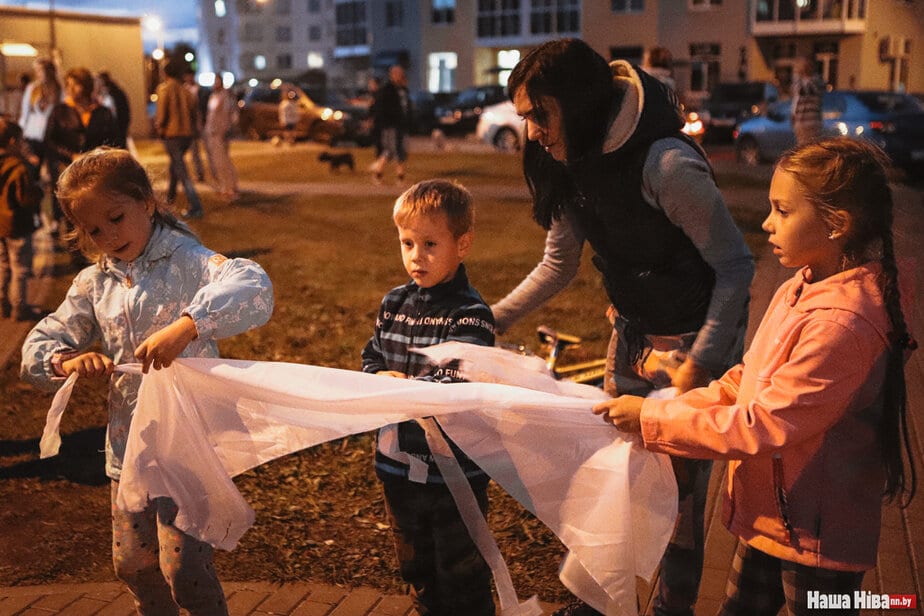
Photo: © Nadzeya Buzhan / Nasha Niva
Some parents see it differently. “I openly tell my son that the white, red and white flag is our historical flag. Our current national flag is a different one because they took our white, red and white flag away in 1994. We tell him that people are angry because they were betrayed during the election. Why shouldn’t we be honest with him?”, says Vadsim, whose son is still in preschool.
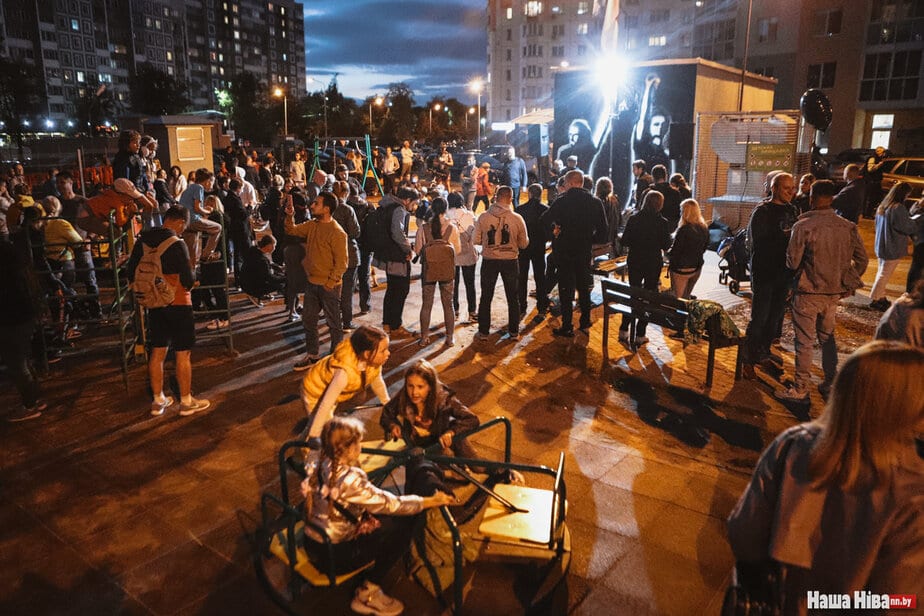
Photo: © Nadzeya Buzhan / Nasha Niva
Lots of older people are present too. “These parties don’t bother me at all. On the contrary. I’ve been listening to this music for 34 years, and I go to the protests,” says one resident proudly. He is 56 years old and works as an engineer at a government enterprise. He says he was recently taken into police custody for one night, and his supervisors threatened to lay him off. “But they changed their minds on the condition that I don’t get picked up again. I told them, ‘I’ll try but I can’t guarantee it.’ I don’t want to lose my job, but who can stay home when they’re arresting 17-year-old girls?” Vaizyushkevich takes the stage and starts off with Mury [a protest anthem – editor’s note dekoder]. The people sing along.
It’s quiet in the courtyard for now. Two days before, on 7 September, some OMON unitsOMON (Otryad Mobilny Osobogo Naznacheniya – Mobile Unit of Special Purpose”) comprises various special units of the Belarusian militia (police). They are mainly used for demonstrations and mass events but are also used for hostage-taking, actions against organized crime, or property protection. came by, although not until everything was over. But they still arrested two people. “I wanted to clear the trash from the playground, but then a bunch of siloviki vehicles pulled up and surrounded me so I couldn’t escape. They took me and a neighbour with them. He was only just coming home from work,” says Vasil, who is also a resident here. He got off more lightly that many people. The siloviki took him and his neighbour to the station and let them go the next day. “They took a report and accused us of disturbing the peace, but they said if the militia doesn’t call us within ten days we’d be alright,” says Vasil.
Vasil is an IT specialist who works with German business partners. He says that when they heard about the internet shutdown and the arrests, they offered him a business trip to Germany for one to two months and then a full relocation package later. “I’m not ready to take that step yet. I love this country, and I want to live here. It’s great here, the people are wonderful,” says Vasil. “But if nothing changes, I will leave as a last resort. I have a little boy, and I want him to grow up in a country where people are appreciated.”
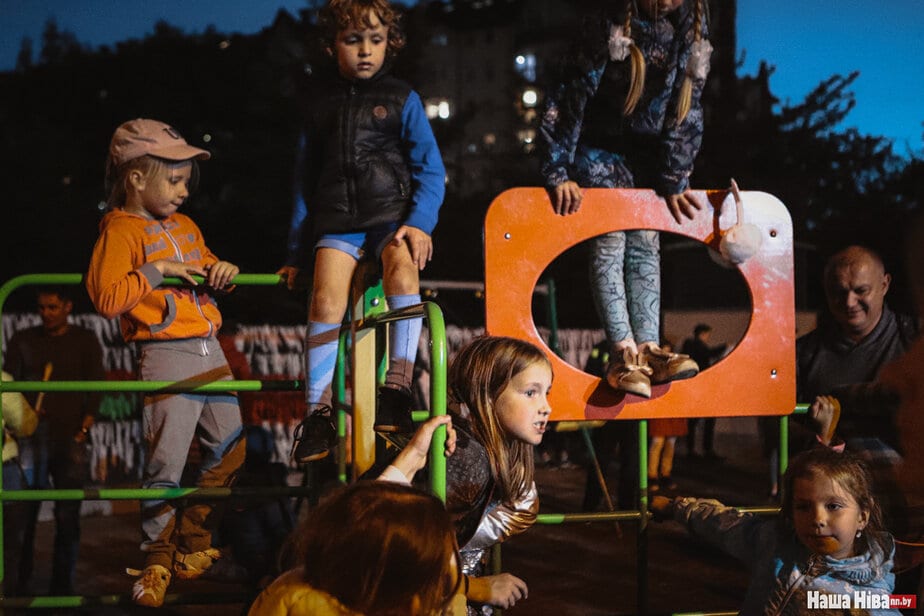
Photo: © Nadzeya Buzhan / Nasha Niva
A half an hour after the concert ends, two small buses with OMON units pull into the courtyard. A large bus is parked further off. People start to panic but they stay put. Vaizyushkevich keeps singing. The children are still running around. The siloviki are still sitting in their vehicles. A ten-year-old on his bike shouts, “The OMON people are here!” The siloviki don’t wait long. As the people sing along to the song Kupalinka, the figures in black move onto the playground. The singing stops in the middle of the song, and people yell thank you to Vaizyushkevich. Some of them leave the playground. Others get blocked in.
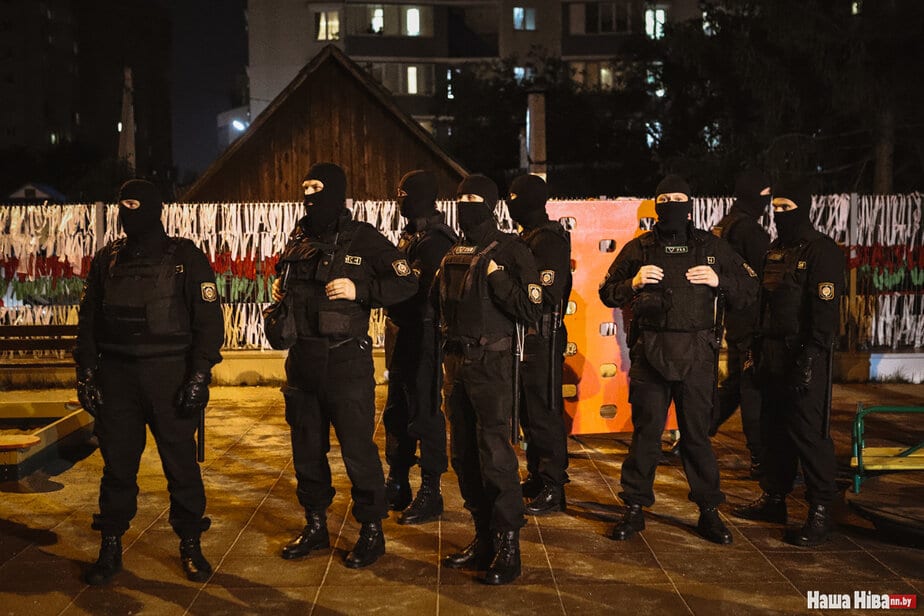
Photo: © Nadzeya Buzhan / Nasha Niva
The siloviki use a megaphone to warn the people that they are holding an “unauthorised event”. The people are outraged, and they respond by saying that they are residents here. Some women shout, “You’re scaring our children. Get out of here!” The OMON people let those through who want to leave. No arrests are made, but the people don’t disperse completely either. Some of them stand at the building entrances, others go back to their apartments and watch through the windows. Meanwhile, more siloviki emerge. Except they are in green uniforms, not black ones. They surround the transformer building, and one starts painting over the mural of the DJs with black paint.
“You’re disgraceful!” shout the crowd. The OMON people respond by showing ostentatious outrage amongst themselves, as if to say, ‘These people drag their kids out here at this hour and then they have the nerve to complain about us?! What’s wrong with them?!’ The residents continue to shout at them. “This is our courtyard!” “Long live Belarus!” But the siloviki don’t budge until the mural is completely destroyed. Then the ones in black uniforms leave. A dozen siloviki in unidentifiable militia uniforms or green uniforms stay. The residents ask them to state their names or present some identification but the uniformed men do not answer.
Little by little, a few dozen residents return to the square. Some of them try to talk with the siloviki. They respond, saying the people should talk amongst themselves. One of the residents takes out a Bible and starts to read to the siloviki from the Book of Revelation. A silovik with a GoPro camera on his helmet uses a smart phone to film the man as he reads. “And I saw when he opened the sixth seal, and there was a great earthquake; and the sun became black as sackcloth of hair, and the whole moon became as blood,” the man says aloud. A few feet away, children swing on the swings and residents offer one another tea and coffee. The dogs sniff each other. The siloviki stand on the playground in front of them. The air smells of the paint that was used to cover up the mural.
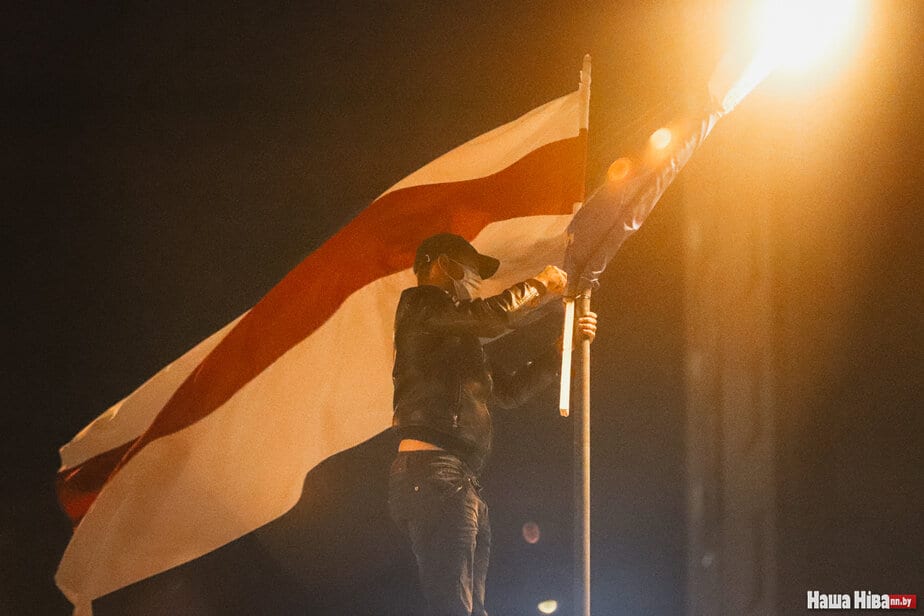
Photo: © Nadzeya Buzhan / Nasha Niva
The protests are getting smaller these days, but the absurdity of the situation is clearly growing. The siloviki bring in a couple of blokes whose faces look tired from alcohol. We’re told they are municipal service workers. They are carrying a ladder, which one of them climbs to the roof of the transformer station. He potters around for quite some time trying to remove the white, red and white flag. He eventually accomplishes his mission. They remove the national flag and the flag of Minsk as well.
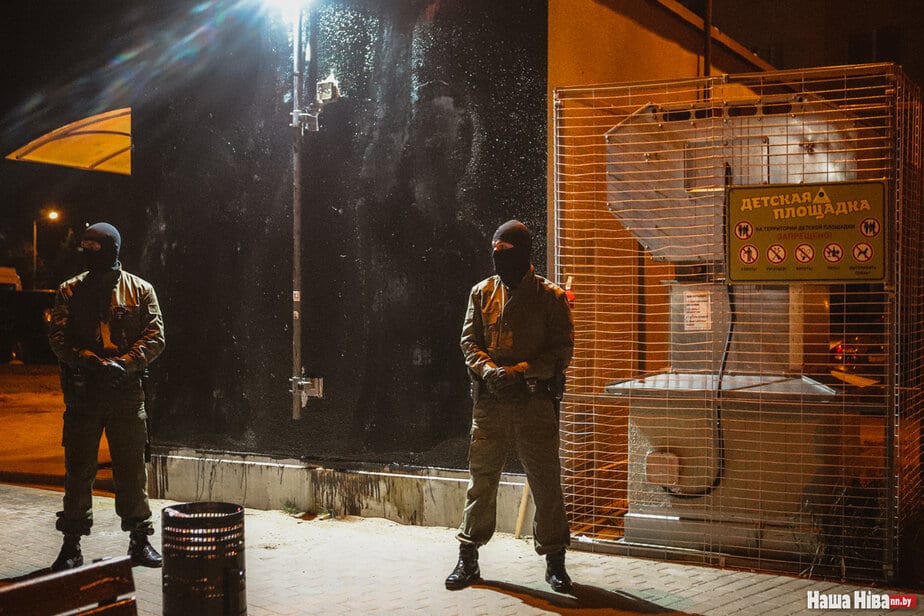
Photo: © Nadzeya Buzhan / Nasha Niva
The square empties. As the residents go home, they thank their neighbours, wish one another good night, and say, “See you tomorrow!” The siloviki leave too. Just a short time earlier, adults were singing and children were playing here. Now it’s quiet. And instead of DJs on the wall, there are two siloviki in masks who have been assigned to stay until the foul-smelling paint has dried. Once again, the heroic siloviki have put the incompetent Czech puppetAn allusion to statements made by Alexander Lukashenko that the protests in Belarus were being controlled by “puppeteers” from abroad. masters in their place.
Original in Belarusian.
First published on 10 September 2020 on Nashaniva.by and on 11 September 2020 on dekoder.org in German.
Translation into English by Douglas Fox.
This text is protected by copyright: © Ulad Shviadovich / Nasha Niva / dekoder. If you are interested in republication, please contact the editorial team.
Copyright information on pictures, graphics and videos are noted directly at the illustrations. Cover picture: © Nadzeya Buzhan / Nasha Niva